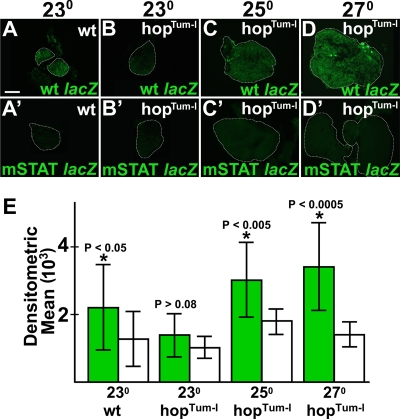FIG. 8.
ush hematopoietic CRM activity in hopTum-l mutant lymph glands. Shown are data for wild-type (wt)and mutant STAT binding site (mSTAT) ush hematopoietic CRM activity in wild-type or hopTum-l second-instar larval lymph glands (fluorescence microscopy) (magnification, ×40). (A and B′) Wild-type and mSTAT ush hematopoietic CRM activity in wild-type second-instar larval lymph glands of animals cultured at 23°C. (B, C, and D) Wild-type hematopoietic CRM activity in hopTum-l lymph glands cultured at the following temperatures: 23°C (B), 25°C (C), and 27°C (D). (B′, C′, and D′) mSTAT hematopoietic CRM activity in hopTum-l lymph glands cultured at the following temperatures: 23°C (B′), 25°C (C′), and 27°C (D′). (E) Densitometric means of wild-type (green bars) and mSTAT (white bars) ush hematopoietic CRM activity in wild-type and hopTum-l lymph glands. Densitometric means of wild-type lymph glands carrying the wild-type and mSTAT ush hematopoietic CRM were 2,216 ± 1,258 and 1,272 ± 810, respectively (P < 0.05). Densitometric means of hopTum-l lymph glands carrying the wild-type or mSTAT ush hematopoietic CRM were as follows: 1,392 ± 636 (wild type) and 1,017 ± 323 (mSTAT) for lymph glands cultured at 23°C (P > 0.08), 3,046 ± 1,126 (wild type) and 1,787 ± 369 (mSTAT) for lymph glands cultured at 25°C (P < 0.005), and 3,391 ± 1,298 (wild type) and 1,435 + 369 (mSTAT) for lymph glands cultured at 27°C (P < 0.0005). Asterisks indicate a significant difference (Student t test) between wild-type and mSTAT CRMs. Scale bar, 50 μm.

